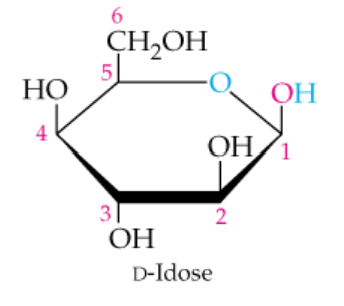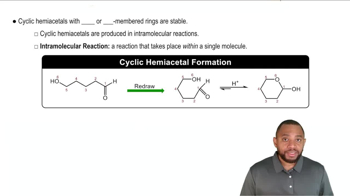Here are the essential concepts you must grasp in order to answer the question correctly.
Cyclic and Straight-Chain Forms of Sugars
Sugars can exist in cyclic and straight-chain forms. In aqueous solutions, many monosaccharides, like d-idose, predominantly adopt a cyclic structure due to the reaction between the carbonyl group and a hydroxyl group. The straight-chain form, known as the Fischer projection, represents the sugar in its open-chain state, which is essential for understanding its reactivity and properties.
Recommended video:
Cyclic Hemiacetals Concept 2
Fischer Projection
The Fischer projection is a two-dimensional representation of a molecule, particularly useful for depicting carbohydrates. In this format, the most oxidized carbon is placed at the top, and the horizontal lines represent bonds that project out of the plane towards the viewer, while vertical lines represent bonds going behind the plane. This method helps visualize the stereochemistry of sugars and their functional groups.
Recommended video:
Fischer Projections Example 1
Aldoses and Ketoses
Aldoses and ketoses are two classes of monosaccharides distinguished by the position of their carbonyl group. Aldoses, like d-idose, have an aldehyde group at one end, while ketoses have a ketone group typically at the second carbon. Understanding this distinction is crucial for converting between cyclic and straight-chain forms, as it influences the structure and reactivity of the sugar.
Recommended video:
Ketoses as Reducing Sugars Concept 2

 Verified step by step guidance
Verified step by step guidance Verified video answer for a similar problem:
Verified video answer for a similar problem:



 2:49m
2:49m